#AI scheduling tools
Explore tagged Tumblr posts
Text
Scaling Smart: How AI Helps Businesses Grow Without Chaos
Scaling Smart How AI Helps Businesses Grow Without Chaos When we talk about scaling a business, most people picture endless meetings, growing pains, and a to-do list so long it deserves its own zip code. But what if growth didn’t have to be chaotic? What if AI-powered automation could help businesses expand effortlessly… without the burnout? AI isn’t just a fancy buzzword; it’s the secret…
#AI and business success#AI and workflow automation#AI business strategies#AI chatbots for business#AI customer insights#AI decision-making#AI for business growth#AI for business owners#AI for customer experience#AI for entrepreneurs#AI for scaling startups#AI for small businesses#AI for startups#AI for sustainable growth#AI in e-commerce#AI scheduling tools#AI workflow optimization#AI-driven business scaling#AI-driven marketing#AI-driven productivity#AI-powered analytics#AI-powered automation#AI-powered efficiency#AI-powered operations#AI-powered project management#business automation tools#Business Growth#business growth without chaos#Business Strategy#Entrepreneur
0 notes
Text
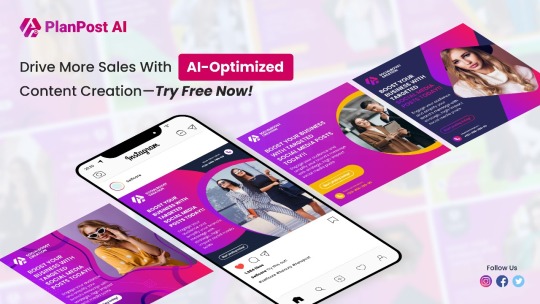
How AI-Driven Marketing & Automation Are Revolutionizing Digital Advertising in 2025
The digital advertising landscape is undergoing a seismic shift. By 2025, the global digital ad market is projected to exceed $1.3 trillion, driven by advancements in artificial intelligence (AI) and automation. Brands that fail to adapt risk being left behind. In this article, we explore how AI-driven marketing and automation are reshaping strategies, enhancing efficiency, and delivering unprecedented ROI in 2025.
The Rise of AI in Marketing
AI has evolved from a buzzword to a core component of marketing strategies. By 2025, over 80% of industry leaders will leverage AI tools to optimize campaigns, personalize experiences, and predict consumer behavior. Machine learning algorithms now process vast datasets in real time, enabling marketers to make data-driven decisions faster than ever.
Key Trends Shaping AI-Driven Marketing in 2025
1. Hyper-Personalization at Scale
Gone are the days of generic ads. AI analyzes behavioral, demographic, and contextual data to craft hyper-personalized content. For example:
Dynamic Email Campaigns: Tools like PlanPost AI generate tailored subject lines and product recommendations, boosting open rates by 40%.
Personalized Ads: AI adjusts creatives in real time based on user interactions, increasing conversion rates by 30%.
2. Predictive Analytics and Decision-Making
AI’s predictive capabilities allow brands to forecast trends and consumer needs. PlanPost AI’s predictive analytics tools, for instance, help businesses allocate budgets to high-performing channels, reducing wasted ad spend by up to 50%.
3. Autonomous Campaign Management
Self-optimizing campaigns are the future. AI algorithms adjust bids, audiences, and creatives autonomously. A clothing brand using PlanPost AI reported a 25% increase in ROAS after switching to AI-managed campaigns.
4. Enhanced Customer Journey Mapping
AI identifies gaps in the customer journey by analyzing touchpoints across devices and platforms. This enables brands to deliver seamless experiences, improving retention by 35%.
5. Voice and Visual Search Optimization
With 60% of consumers using voice or visual search in 2025, AI tools optimize content for natural language queries and image recognition, ensuring brands remain visible in evolving search ecosystems.
The Role of Automation in Digital Advertising
Programmatic Advertising 2.0
Automation powers real-time bidding (RTB) and ad placements. AI-enhanced programmatic platforms like PlanPost AI analyze user intent, serving ads at the perfect moment while reducing costs by 20%.
Chatbots and Conversational AI
Intelligent chatbots handle 70% of customer interactions by 2025, resolving queries instantly and nurturing leads 24/7.
AI-Powered Content Generation
Tools like PlanPost AI create high-quality blog posts, social media captions, and video scripts in minutes, freeing teams to focus on strategy.
Cross-Channel Integration
Automation unifies campaigns across Google Ads, Meta, TikTok, and emerging platforms. AI tracks performance metrics, reallocating budgets dynamically for maximum impact.
PlanPost AI: Your Partner in the AI Marketing Revolution
PlanPost AI stands out as a comprehensive solution for 2025’s challenges. Key features include:
Predictive Budget Allocation: Maximize ROI with AI-driven spend recommendations.
Dynamic Creative Optimization (DCO): Auto-generate ads tailored to individual users.
Cross-Platform Analytics: Track performance in real time across 10+ channels.
Ethical AI Compliance: Built-in safeguards to ensure data privacy and reduce bias.
Challenges and Ethical Considerations
While AI offers immense potential, challenges persist:
Data Privacy: Stricter regulations like GDPR require transparent data usage.
Algorithmic Bias: Regular audits are critical to avoid skewed outcomes.
Over-Automation: Balancing AI efficiency with human creativity remains key.
Conclusion: Embrace the Future Today
AI-driven marketing and automation aren’t just trends—they’re the foundation of 2025’s digital advertising ecosystem. Brands that adopt tools like PlanPost AI will dominate through hyper-personalized campaigns, predictive insights, and seamless cross-channel execution.
Ready to revolutionize your strategy? Explore PlanPost AI’s cutting-edge solutions and stay ahead in the AI marketing race.
#business#design#tech#artificial intelligence#graphic design#copywriting#scheduled#ai content creation#ai content generation#social media marketing#ai content tools#digital marketing#ai image#technology
2 notes
·
View notes
Text
Funny how he said he did this to “help” ppl with dyslexia/eye problems etc and yet charges money for it?!
If you really want to help you’d offer this for free forever. Even then it would be a concern because you’re using works that aren’t your own & you use them without permission, but at least then I could believe the good intentions you said you have.
All that aside, ai am heartbroken because damage is already done. AI has been fed and we can’t delete that information any more. And the more this happens, the better these programs will become. I think of it like a cancer or a bacterial infection. If you keep eating , let’s say sugars, the bacteria will keep feeding and growing. You have to cut off the source to make it stagnate, but that’s impossible, since sugar is in almost every food. You have to eat to survive so you will feed the cancer, too, even if you’re slowing down the growth. So, the best way is to cut the whole thing out. That would be a ban or law on using AI technology. Why has this not happened yet?
I think fighting in this instance is hugely important and I will check my own works, too, but it feels like we’re only fighting the symptoms here. If that guy can do it, someone else will, too. And eventually it will be too many to fight them all.

SO HERE IS THE WHOLE STORY (SO FAR).
I am on my knees begging you to reblog this post and to stop reblogging the original ones I sent out yesterday. This is the complete account with all the most recent info; the other one is just sending people down senselessly panicked avenues that no longer lead anywhere.
IN SHORT
Cliff Weitzman, CEO of Speechify and (aspiring?) voice actor, used AI to scrape thousands of popular, finished works off AO3 to list them on his own for-profit website and in his attached app. He did this without getting any kind of permission from the authors of said work or informing AO3. Obviously.
When fandom at large was made aware of his theft and started pushing back, Weitzman issued a non-apology on the original social media posts—using
his dyslexia;
his intent to implement a tip-system for the plagiarized authors; and
a sudden willingness to take down the work of every author who saw my original social media posts and emailed him individually with a ‘valid’ claim,
as reasons we should allow him to continue monetizing fanwork for his own financial gain.
When we less-than-kindly refused, he took down his ‘apologies’ as well as his website (allegedly—it’s possible that our complaints to his web host, the deluge of emails he received or the unanticipated traffic brought it down, since there wasn’t any sort of official statement made about it), and when it came back up several hours later, all of the work formerly listed in the fan fiction category was no longer there.
THE TAKEAWAYS
1. Cliff Weitzman (aka Ofek Weitzman) is a scumbag with no qualms about taking fanwork without permission, feeding it to AI and monetizing it for his own financial gain;
2. Fandom can really get things done when it wants to, and
3. Our fanworks appear to be hidden, but they’re NOT DELETED from Weitzman’s servers, and independently published, original works are still listed without the authors' permission. We need to hold this man responsible for his theft, keep an eye on both his current and future endeavors, and take action immediately when he crosses the line again.
THE TIMELINE, THE DETAILS, THE SCREENSHOTS (behind the cut)
Sunday night, December 22nd 2024, I noticed an influx in visitors to my fic You & Me & Holiday Wine. When I searched the title online, hoping to find out where they came from, a new listing popped up (third one down, no less):

This listing is still up today, by the way, though now when you follow the link to word-stream, it just brings you to the main site. (Also, to be clear, this was not the cause for the influx of traffic to my fic; word-stream did not link back to the original work anywhere.)
I followed the link to word-stream, where to my horror Y&M&HW was listed in its entirety—though, beyond the first half of the first chapter, behind a paywall—along with a link promising to take me—through an app downloadable on the Apple Store—to an AI-narrated audiobook version. When I searched word-stream itself for my ao3 handle I found both of my multi-chapter fics were listed this way:

Because the tags on my fics (which included genres* and characters, but never the original IPs**) weren’t working, I put ‘Kara Danvers’ into the search bar and discovered that many more supercorp fics (Supergirl TV fandom, Kara Danvers/Lena Luthor pairing) were listed.
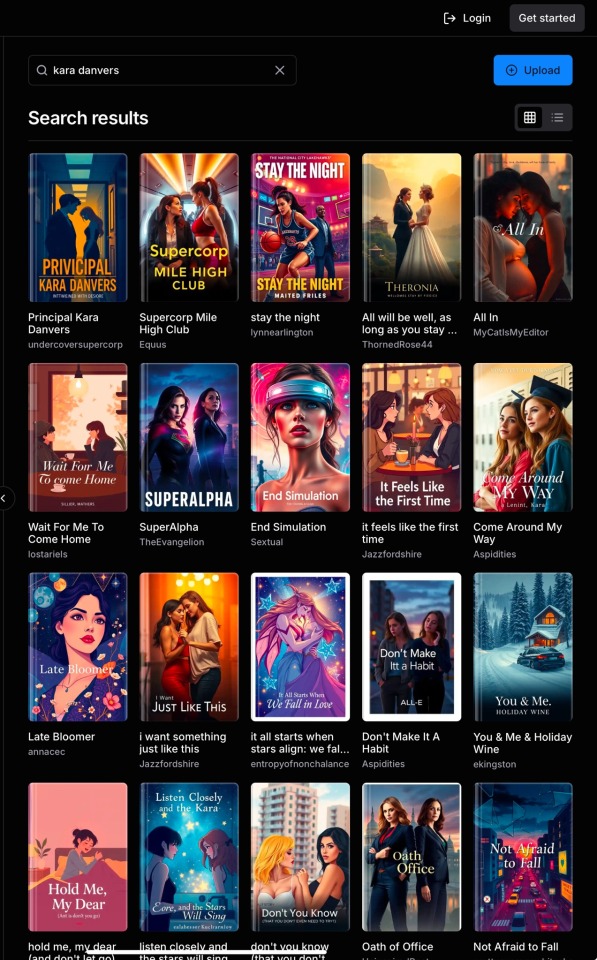
I went looking online for any mention of word-stream and AI plagiarism (the covers—as well as the ridiculously inflated number of reviews and ratings—made it immediately obvious that AI fuckery was involved), but found almost nothing: only one single Reddit post had been made, and it received (at that time) only a handful of upvotes and no advice.
I decided to make a tumblr post to bring the supercorp fandom up to speed about the theft. I draw as well as write for fandom and I’ve only ever had to deal with art theft—which has a clear set of steps to take depending on where said art was reposted—and I was at a loss regarding where to start in this situation.
After my post went up I remembered Project Copy Knight, which is worth commending for the work they’ve done to get fic stolen from AO3 taken down from monetized AI 'audiobook’ YouTube accounts. I reached out to @echoekhi, asking if they’d heard of this site and whether they could advise me on how to get our works taken down.

While waiting for a reply I looked into Copy Knight’s methods and decided to contact OTW’s legal department:
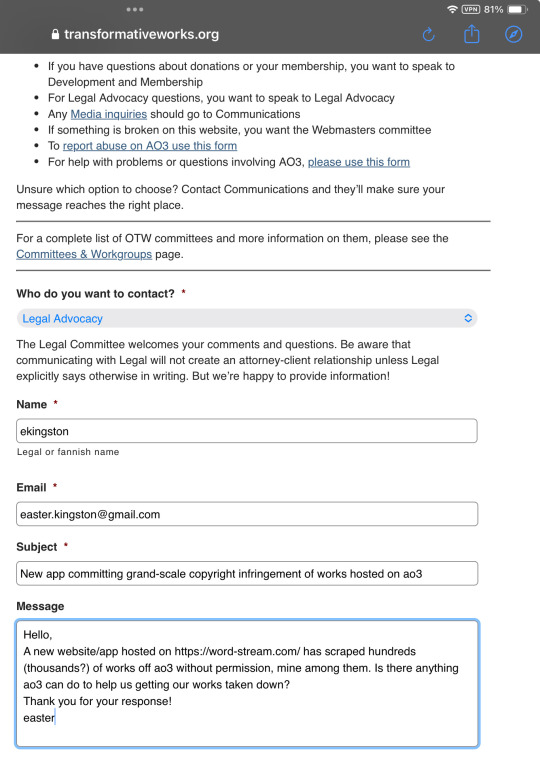
And then I went to bed.
By morning, tumblr friends @makicarn and @fazedlight as well as a very helpful tumblr anon had seen my post and done some very productive sleuthing:

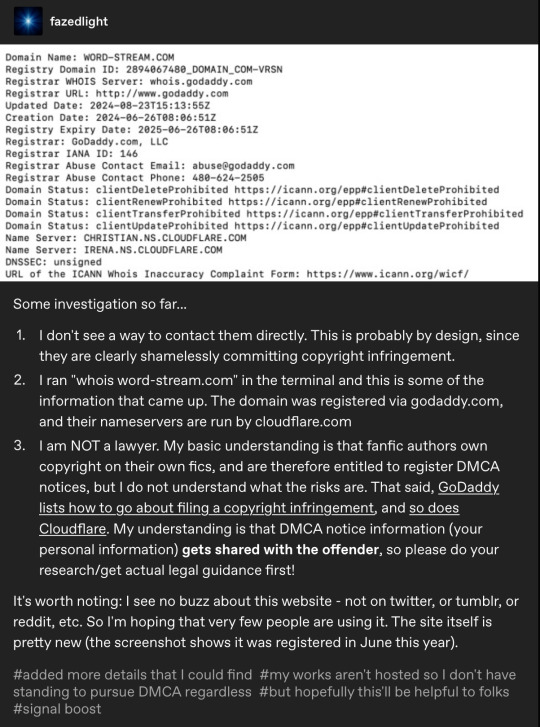
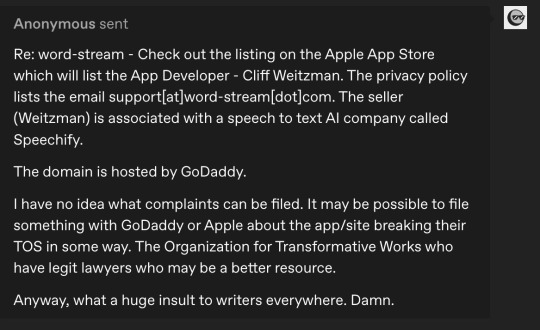
@echoekhi had also gotten back to me, advising me, as expected, to contact the OTW. So I decided to sit tight until I got a response from them.
That response came only an hour or so later:
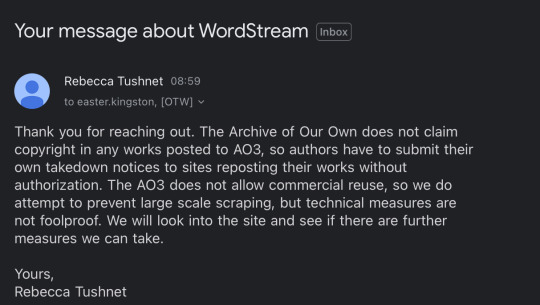
Which was 100% understandable, but still disappointing—I doubted a handful of individual takedown requests would accomplish much, and I wasn’t eager to share my given name and personal information with Cliff Weitzman himself, which is unavoidable if you want to file a DMCA.
I decided to take it to Reddit, hoping it would gain traction in the wider fanfic community, considering so many fandoms were affected. My Reddit posts (with the updates at the bottom as they were emerging) can be found here and here.
A helpful Reddit user posted a guide on how users could go about filing a DMCA against word-stream here (to wobbly-at-best results)
A different helpful Reddit user signed up to access insight into word-streams pricing. Comment is here.
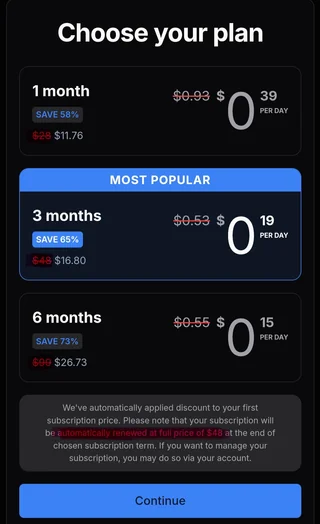
Smells unbelievably scammy, right? In addition to those audacious prices—though in all fairness any amount of money would be audacious considering every work listed is accessible elsewhere for free—my dyscalculia is screaming silently at the sight of that completely unnecessary amount of intentionally obscured numbers.
Speaking of which! As soon as the post on r/AO3—and, as a result, my original tumblr post—began taking off properly, sometime around 1 pm, jumpscare! A notification that a tumblr account named @cliffweitzman had commented on my post, and I got a bit mad about the gist of his message :
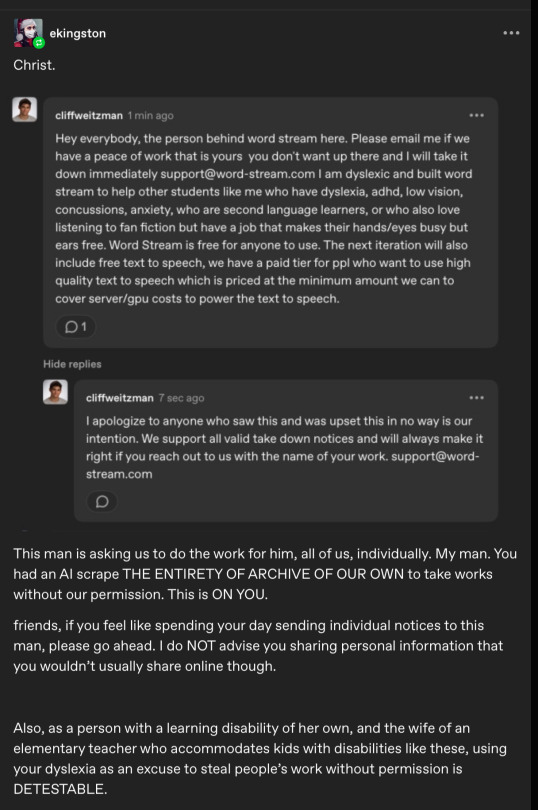
Fortunately he caught plenty of flack in the comments from other users (truly you should check out the comment section, it is extremely gratifying and people are making tremendously good points), in response to which, of course, he first tried to both reiterate and renegotiate his point in a second, longer comment (which I didn’t screenshot in time so I’m sorry for the crappy notification email formatting):

which he then proceeded to also post to Reddit (this is another Reddit user’s screenshot, I didn’t see it at all, the notifications were moving too fast for me to follow by then)
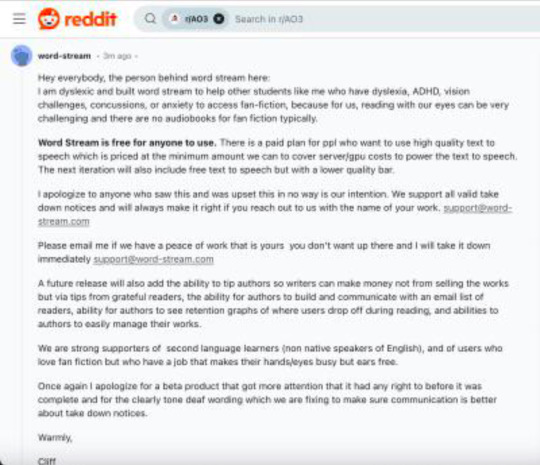
... where he got a roughly equal amount of righteously furious replies. (Check downthread, they're still there, all the way at the bottom.)
After which Cliff went ahead & deleted his messages altogether.
It’s not entirely clear whether his account was suspended by Reddit soon after or whether he deleted it himself, but considering his tumblr account is still intact, I assume it’s the former. He made a handful of sock puppet accounts to play around with for a while, both on Reddit and Tumblr, only one of which I have a screenshot of, but since they all say roughly the same thing, you’re not missing much:

And then word-stream started throwing a DNS error.
That lasted for a good number of hours, which was unfortunately right around the time that a lot of authors first heard about the situation and started asking me individually how to find out whether their work was stolen too. I do not have that information and I am unclear on the perimeters Weitzman set for his AI scraper, so this is all conjecture: it LOOKS like the fics that were lifted had three things in common:
They were completed works;
They had over several thousand kudos on AO3; and
They were written by authors who had actively posted or updated work over the past year.
If anyone knows more about these perimeters or has info that counters my observation, please let me know!
I finally thought to check/alert evil Twitter during this time, and found out that the news was doing the rounds there already. I made a quick thread summarizing everything that had happened just in case. You can find it here.
I went to Bluesky too, where fandom was doing all the heavy lifting for me already, so I just reskeeted, as you do, and carried on.
Sometime in the very early evening, word-stream went back up—but the fan fiction category was nowhere to be seen. Tentative joy and celebration!***
That’s when several users—the ones who had signed up for accounts to gain intel and had accessed their own fics that way—reported that their work could still be accessed through their history. Relevant Reddit post here.
Sooo—
We’re obviously not done. The fanwork that was stolen by Weitzman may be inaccessible through his website right now, but they aren’t actually gone. And the fact that Weitzman wasn’t willing to get rid of them altogether means he still has plans for them.
This was my final edit on my Reddit post before turning off notifications, and it's pretty much where my head will be at for at least the foreseeable future:
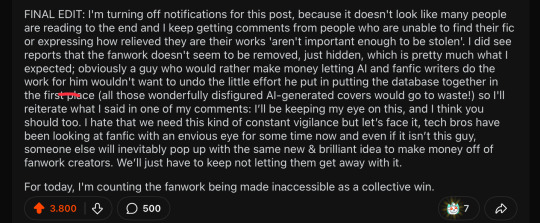
Please feel free to add info in the comments, make your own posts, take whatever action you want to take to protect your work. I only beg you—seriously, I’m on my knees here—to not give up like I saw a handful of people express the urge to do. Keep sharing your creative work and remain vigilant and stay active to make sure we can continue to do so freely. Visit your favorite fics, and the ones you’ve kept in your ‘marked for later’ lists but never made time to read, and leave kudos, leave comments, support your fandom creatives, celebrate podficcers and support AO3. We created this place and it’s our responsibility to keep it alive and thriving for as long as we possibly can.
Also FUCK generative AI. It has NO place in fandom spaces.
THE 'SMALL' PRINT (some of it in all caps):
*Weitzman knew what he was doing and can NOT claim ignorance. One, it’s pretty basic kindergarten stuff that you don’t steal some other kid’s art project and present it as your own only to act surprised when they protest and then tell the victim that they should have told you sooner that they didn’t want their project stolen. And two, he was very careful never to list the IPs these fanworks were based on, so it’s clear he was at least familiar enough with the legalities to not get himself in hot water with corporate lawyers. Fucking over fans, though, he figured he could get away with that.
**A note about the AI that Weitzman used to steal our work: it’s even greasier than it looks at first glance. It’s not just the method he used to lift works off AO3 and then regurgitate onto his own website and app. Looking beyond the untold horrors of his AI-generated cover ‘art’, in many cases these covers attempt to depict something from the fics in question that can’t be gleaned from their summaries alone. In addition, my fics (and I assume the others, as well) were listed with generated genres; tags that did not appear anywhere in or on my fic on AO3 and were sometimes scarily accurate and sometimes way off the mark. I remember You & Me & Holiday Wine had ‘found family’ (100% correct, but not tagged by me as such) and I believe The Shape of Soup was listed as, among others, ‘enemies to friends to lovers’ and ‘love triangle’ (both wildly inaccurate). Even worse, not all the fic listed (as authors on Reddit pointed out) came with their original summaries at all. Often the entire summary was AI-generated. All of these things make it very clear that it was an all-encompassing scrape—not only were our fics stolen, they were also fed word-for-word into the AI Weitzman used and then analyzed to suit Weitzman’s needs. This means our work was literally fed to this AI to basically do with whatever its other users want, including (one assumes) text generation.
***Fan fiction appears to have been made (largely) inaccessible on word-stream at this time, but I’m hearing from several authors that their original, independently published work, which is listed at places like Kindle Unlimited, DOES still appear in word-stream’s search engine. This obviously hurts writers, especially independent ones, who depend on these works for income and, as a rule, don’t have a huge budget or a legal team with oceans of time to fight these battles for them. If you consider yourself an author in the broader sense, beyond merely existing online as a fandom author, beyond concerns that your own work is immediately at risk, DO NOT STOP MAKING NOISE ABOUT THIS.
Again, please, please PLEASE reblog this post instead of the one I sent originally. All the information is here, and it's driving me nuts to see the old ones are still passed around, sending people on wild goose chases.
Thank you all so much.
#we are interrupting our scheduled program for this very important message#holy shit#this is fucked up#plagiarism#fandom#ao3#ai technology#ai tools#fuck ai#ai plagiarism#stolen art#speechify#word-stream#cliff weitzman
48K notes
·
View notes
Text
How AI Can Automate Your Indie Music Marketing (Without Losing Your Soul)
Making a Scene Presents How AI Can Automate Your Indie Music Marketing (Without Losing Your Soul) Explore tools for scheduling, targeting, and content creation while staying true to your voice. If you’re an indie musician, you’ve probably had this moment: you’re excited about a new track, maybe you’ve just released it on Bandcamp, Spotify, or Audius. You sit at your laptop with a cup of coffee,…
#ai content creation for musicians#ai for song promotion#ai for spotify campaigns#ai for tiktok reels#ai music marketing#ai music strategy#ai social media scheduling#ai vs human creativity#artist branding with ai#authentic ai branding#automate music marketing#beatchain analytics#canva music promo#chatgpt for musicians#cyanite ai#diy musician promotion#indie artist growth#indie artist marketing#indie musician tools#jasper ai music#music marketing automation#music marketing strategy#music promotion with ai#pictory video creation#runwayml visuals#smart marketing stack#tonedon targeting#web3 music tools
0 notes
Text
Top SaaS Scheduler Tools Compared: Which One Is Right for You?
In today’s digital world, posting on social media is very important for brands, marketers, and creators. It helps them share their ideas, promote their products, and stay connected with their audience. However, daily posting on different platforms like Instagram, Facebook, or LinkedIn can take a lot of time and effort. That’s where social media scheduling tools come in.
These tools let you plan and schedule your posts ahead of time. You can choose the date and time for each post, and the tool will automatically publish it for you. This saves a lot of time and helps you stay organized. It also makes sure your content reaches people when they are most active online.
In this blog, we will compare some of the top social media scheduler tools available today. This includes popular tools like Buffer, Planable, and Hootsuite, as well as Indzu — a smart and simple tool made for creators, freelancers, and small teams.
By the end of this blog, you’ll know which scheduler fits your needs the best and how it can help you manage your social media more smartly.
What to Look for in a Scheduler Tool
When choosing a scheduler tool, it's important to look at a few key features. First, the tool should be easy to use. You shouldn't need to be a tech expert to understand it. A simple design saves time and helps you focus on your content.
Next, check if it supports multiple platforms like Instagram, Facebook, Twitter, LinkedIn, or TikTok. This way, you can post to all your social media accounts from one place.
Collaboration features are useful if you're working with a team. They let you share drafts, get approvals, and leave comments—all in the same tool.
A good calendar view helps you plan your posts ahead. You can see which posts are going out on which days and make changes if needed.
Auto-posting means the tool will publish your posts at the right time without you doing it manually. Some tools also let you recycle old posts, so your best content can be shared again.
Lastly, look at the pricing. Some tools are free with basic features, while others offer more options in paid plans. Choose one that fits your needs and budget.
1. Indzu
Indzu is a smart and easy-to-use social media scheduler made for both individuals and teams. Whether you are a freelancer, content creator, or part of a growing business, Indzu helps you save time and stay organized.
The platform has a clean and simple interface, so you don’t need to be a tech expert to use it. You can schedule posts for all major platforms like Instagram, Facebook, LinkedIn, and more. Just set the time and date, and Indzu will post it for you—no need to log in every time.
One of Indzu’s special features is its AI-powered content suggestions. If you’re not sure what to post, the tool gives you smart ideas based on your brand and goals. You can also set custom queues, so your content goes out exactly when your audience is most active.
Indzu is perfect for small teams that need to manage social media together. The pricing is affordable, and the plans grow with your needs. Whether you are just starting or managing multiple accounts, Indzu makes social media easier and faster.
2. Planable
Planable is a social media scheduling tool that helps teams work together easily. It is made for marketing agencies and big brands that handle many clients at once. One of its best features is the visual content calendar, where you can see all your planned posts in one place. This makes it easy to stay organized.
Planable is also great for teamwork. It allows team members to share their ideas, give feedback, and approve posts in real time. This means your team can work faster without sending emails back and forth. Everyone can see what’s happening and make changes right inside the tool.
The platform is easy to use, but is mainly built for professional teams. If you are a freelancer or just starting, it might feel too advanced or a bit expensive. However, for agencies with many clients, the cost is worth it because of the time it saves.
In short, Planable is a strong choice for big teams that need to plan, review, and post social media content together. It helps teams stay on the same page and work better as a group.
3. Buffer
Buffer is a simple and easy-to-use tool for scheduling social media posts. It has a clean and friendly interface, which makes it great for beginners. Even if you have never used a scheduling tool before, Buffer is easy to learn and use.
With Buffer, you can plan and schedule posts for platforms like Facebook, Twitter, LinkedIn, and Instagram. It also gives you basic analytics to see how your posts are performing—such as how many likes, shares, or comments they get.
One of the best things about Buffer is that it offers a free plan. This plan has limited features but is perfect for solo users or small businesses just getting started. You can schedule a few posts at a time and manage up to three social media accounts with the free version.
Buffer is ideal for solo entrepreneurs, content creators, or small teams who want to save time by planning their posts. While it doesn’t have as many advanced features as other tools, it’s a smart choice for those who want something simple and effective.
If you’re looking for a tool to help you stay active on social media without spending too much time or money, Buffer is worth trying.
4. Hootsuite
Hootsuite is a powerful social media scheduler made for big companies and agencies. It lets users manage many social media accounts all in one place. One of its best features is the Streams Dashboard, which shows live updates from your social media, like comments, messages, and likes. This helps teams quickly respond to their audience and stay updated.
Hootsuite also gives you detailed analytics. This means you can see how well your posts are doing, how many people they reach, and which ones get the most likes or shares. These reports are helpful for businesses that want to improve their online performance.
However, Hootsuite can be expensive, especially for small teams or individuals. The more features you want, the higher the cost. It's mainly made for large businesses with a bigger budget and a need to manage many accounts or clients at once.
In short, Hootsuite is a great tool for professional teams who need strong features, but it may not be the best choice if you’re just starting or working with a small team. For smaller budgets or simpler needs, other tools might be a better fit.
5. Later
Later is a popular social media scheduler, especially for people and brands who post a lot on Instagram. One of its best features is the drag-and-drop calendar. This means you can easily move your posts around to pick the perfect day and time to share them. It’s very visual and simple to use, which makes it great for beginners.
Later also offers something called Linkin.bio, which helps you turn your Instagram bio link into a mini website. This is very useful if you want to send your followers to different websites, products, or blog posts through your Instagram profile.
While Later supports other platforms like Facebook, Twitter, Pinterest, and TikTok, its main strength is still Instagram. If you are a content creator, influencer, or small business focused on Instagram marketing, Later is a good choice.
However, some advanced features—like detailed analytics or automatic publishing—are only available in higher-priced plans. So, if you are using the free or basic plan, you might not get all the tools.
Conclusion
Each social media scheduler tool is made for different types of users. Planable is great for big teams and marketing agencies that need to work together closely. Buffer is perfect for people who are just starting or running a small business. Hootsuite is a strong tool for big companies that need advanced features. Later is best for users who post a lot on Instagram and want a visual way to plan their content.
Indzu is a smart and easy tool made for individuals, freelancers, and small teams. It helps you plan and schedule your social media posts without stress. You can manage your content for different platforms in one place, get helpful content suggestions, and save time every week. It is simple to use but still gives you powerful features like custom post timing and team support. Indzu grows with you, so it works well even as your needs grow.
If you want a tool that is simple, smart, and built for creators and teams, Indzu is the right choice.
Try Indzu free today and streamline your social media like a pro!
#AI social media management tool#AI social media manager#AI powerd social media management tool#AI socila media scheduling tool#AI Social media scheduler#AI powered socila media scheduling tool#AI powered Social media scheduler
0 notes
Text
AI Tools for Social Media Management in 2025
Managing social media in 2025 isn’t just about posting pretty pictures — it’s a strategic game. And guess what? AI is your new teammate. From content creation to scheduling, analytics, and even customer service, AI tools are transforming how brands show up online. Whether you’re a small business owner, digital marketer, or solo creator, this guide breaks down the top AI tools for social media…
0 notes
Text
Many Agents Are Better than One: Transforming Business with AI Orchestration
New Post has been published on https://thedigitalinsider.com/many-agents-are-better-than-one-transforming-business-with-ai-orchestration/
Many Agents Are Better than One: Transforming Business with AI Orchestration


The collaborative power of multi-agent AI is here and ready to radically change how businesses operate, seek information, and make decisions.
If many hands make light work, then imagine what a network of AI agents can achieve.
AI has already improved productivity across industries, but its impact is often limited to isolated silos. For instance, think of an AI chatbot on an ecommerce site. It can handle basic customer inquiries but may struggle to perform more complex tasks that require cross-departmental collaboration, such as providing personalized recommendations, managing customer complaints, or coordinating with other parts of the business, such as inventory management. This fragmented approach not only limits the customer experience but also makes it hard for departments to exchange useful information—leaving potential innovations and productivity gains on the table.
Enter multi-agent AI orchestration – where multiple AI tools, or “agents,” work together seamlessly to drive better and more efficient outcomes. The move toward multi-agent collaboration will only be strengthened by recent breakthroughs, such as DeepSeek, which have introduced a new reality for the efficiency, scalability, and cost-effectiveness of AI.
Imagine multi-agent systems like a team of specialized workers in a factory, each with their own tasks but all working together to build a car. By coordinating their efforts and sharing information, they can achieve much more and do so more efficiently than working in isolation. Now, envision this collaborative power applied across various functions within companies in every industry. This is the transformative potential of multi-agent AI orchestration.
Industries like finance, manufacturing, retail, and others stand to benefit enormously from these technologies. By embracing multi-agent frameworks, organizations can unlock new levels of efficiency and innovation, improve the customer experience, and ultimately bring products and services to market faster.
Multi-Agent AI Systems Have Arrived
Multi-agent systems are no longer just a concept; they will soon transform how businesses operate, seek information, and make decisions. Enterprises are moving to them, leaning less on siloed AI interfaces in favor of a more collaborative approach. A year from now, I expect them to be indispensable in driving efficiency and productivity gains.
Enterprises like biopharmaceutical company Gilead Sciences are already harnessing these systems to transform user engagement, boost productivity, and achieve cost savings. Automating routine tasks and fostering seamless communication enables companies to focus on what they do best. In the case of Gilead, this means their critical work in preventing and treating life-threatening illnesses. Once completed, the system will underpin Gilead’s global IT operations and enable key business functions like finance and HR to communicate through an interconnected system of agents using Large Language Models.
This example highlights the vast potential of this technology beyond any one sector. Following are three key takeaways for leaders for this new era of AI, where multi-agents will work across entire businesses to assist humans in every role, from HR and finance to marketing and sales:
Embrace Multi-Agent Efficiency for a Competitive Edge
This technology offers a strategic advantage by creating a framework where AI agents work together to solve complex problems. By leveraging multi-agent orchestration, leaders can enhance operational efficiency, positioning their organizations ahead of the competition. In manufacturing, agents can manage the supply chain more efficiently by analyzing sales data and market trends to forecast demand, coordinating with suppliers for timely material delivery, and monitoring inventory levels in real-time. Similarly, an AI agent can help predict equipment issues and coordinate with others to schedule maintenance in a way that reduces operational interruptions.
Leverage AI to Enhance Cross-Departmental Collaboration
Breaking down silos and enhancing communication across departments can lead to more cohesive and efficient operations. In the banking sector, AI agents can streamline operations and improve customer service through coordinated efforts. For example, an agent handling customer inquiries can seamlessly transfer relevant information to another agent responsible for processing transactions, ensuring a smooth and efficient customer experience. By implementing these systems, leaders can foster better collaboration and drive overall organizational efficiency.
Tailor AI Solutions to Fit your Unique Needs
These systems are not one-size-fits-all. They should be tailored to meet the unique challenges of each company or industry. In retail, for example, AI agents can enhance the shopping experience by analyzing customer purchase history for personalized recommendations and managing inventory to keep popular items in stock. In healthcare, these systems can assist in patient diagnosis, manage medical records, and streamline appointment scheduling. While the underlying technology is similar, its application is much different. Leaders should work with AI and domain experts to create solutions that align with their goals, ensuring greater value.
The Path Forward
Multi-agent AI systems will transform business operations and innovation. By embracing these technologies, organizations can unlock new levels of efficiency and focus on bringing innovative solutions to market faster. For leaders, the message is clear: the future of business lies in harnessing the power of multi-agent orchestration. Companies that fail to act will fall behind.
#agent#agents#ai#ai agent#AI AGENTS#AI Chatbot#AI systems#ai tools#appointment scheduling#approach#banking#Business#change#chatbot#Cognizant#Collaboration#collaborative#communication#Companies#competition#cost savings#customer experience#customer service#data#deepseek#driving#efficiency#Enterprises#equipment#era
1 note
·
View note
Text
How Has AI Been Successfully Implemented in Real Construction Projects?

View On WordPress
#ai construction design#ai construction scheduling#ai construction takeoff#ai engineering building#ai in construction#can ai read construction drawings#construction ai tools#how to use ai in construction estimating#how will ai affect construction
0 notes
Text
10+ Hours Saved: AI Tools That Make Social Media a Breeze
10+ Hours Saved AI Tools That Make Social Media a Breeze Let’s be real, keeping up with social media feels like a full-time job. Between brainstorming content, filming videos, writing captions, engaging with followers, and remembering to actually run your business, social media can quickly become a time-sucking black hole. But what if you could show up consistently, post daily, and stay…
#AI chatbot for social media#AI content creation#AI content repurposing#AI engagement automation#AI engagement boosters#AI for brand visibility#AI for community management#AI for content batching#AI for content strategy#AI for digital marketing strategy#AI for Facebook automation#AI for influencer marketing#AI for Instagram growth#AI for LinkedIn engagement#AI for small business marketing#AI for social media consistency#AI for social media entrepreneurs#AI for social media marketing#AI for TikTok growth#AI for video marketing#AI for YouTube content#AI scheduling tools#AI social media automation#AI social media captions#AI social media manager#AI social media time-saving#AI social media workflow#AI-driven audience engagement#AI-driven social listening#AI-driven social media growth
0 notes
Text
I can't find it and don't remember who said it but I saw something where op was comparing liberals' reaction to hearing AI the same way conservatives react to hearing pronouns and I'm gonna be thinking about that all night now
#my diary#it's an imperfect comparison cuz unlike the conservative/pronoun hysteria I think the anti-AI camp has some perfectly fair and valid points#I just also think those points are misguided and people are mad at the wrong things#and the assumed endgame(?) that AI as a tool can somehow be... what. defeated? made to go away forever? is frankly naive#I don't bring it up usually cuz I am NOT trying to discredit people's concerns about generative AI in late-stage capitalism#(like I'm a writer you don't have to tell me that automating creative work is dangerous and scary#if I hadn't lost my writing gig in 2022 I definitely would've been outsourced to chatgpt by now)#but the automation is not the problem here it's that our livelihoods depend on things not being automated#automation has been deleting jobs since the industrial revolution (possibly earlier idk I'm history-dumb)#the whole point of automation is ideally to reach a point where none of us HAVE to work anymore#but I concede that this is an extremely unhelpful and callous point to make in early 2025 on tumblr#anyway I'm rambling now cuz I don't wanna get off my butt and go to bed#I think I'm gonna turn my thoughts into an essay#cuz apparently I have a lot of them and maybe I'm finally ready to try writing essays again#oh yeah I'm pivoting the blog idea btw#decided a regular posting schedule was too stressful#and I'm too much of a yapper#so I'm going old-school and bringing the essay back#(I don't think it went anywhere)#I might even make pamphlets or zines#I wanna do more work than a blog but less work than a book you feel me
1 note
·
View note
Text
Preventing Injuries with Real-Time Wearable Technology

Real-time wearable technology is transforming injury prevention and patient care, offering unprecedented insights into human movement and health risks. These intelligent devices, equipped with advanced sensors and AI, continuously track biomechanical signals to help healthcare professionals anticipate and prevent potential injuries. One critical application is addressing pressure injuries—a persistent challenge that impacts patient quality of life and hospital costs.
Traditional preventive measures like frequent patient turning are often inconsistently followed due to the physical demands on nursing staff. Wearable technology sensors now emerge as a game-changing solution, providing continuous monitoring and proactive intervention strategies that traditional methods cannot match.
Key Findings:
1. Real-Time Interventions: Wearable technology sensors offer real-time feedback to ensure patients are turned on schedule. These devices monitor patient movement and positioning, alerting nursing staff immediately if a patient hasn’t been repositioned or if the turn angle isn’t sufficient to relieve pressure. This real-time capability enables prompt corrective actions, directly preventing injuries.
2. Enhanced Compliance: With sensors in place, compliance with turning protocols skyrockets. Studies show increases from as low as 15% to over 80%, reducing the manual effort of tracking patient repositioning.
3. Fewer Injuries: Real-time monitoring has led to a reduction in hospital-acquired pressure injuries (HAPIs) by up to 70%. Patients are safeguarded against severe complications like deep tissue damage.
4. Economic Benefits: Hospitals benefit financially, saving an estimated $6,621 per patient by avoiding pressure injuries. This makes wearable sensors a cost-effective addition to patient care.
5. Improved Teamwork: Sensors encourage better communication and collaboration among nursing staff. They distribute the responsibility of turning patients more evenly, fostering teamwork.
Hospitals Leading the Way
Several hospitals have successfully implemented wearable sensor technology, demonstrating its effectiveness:
Stanford Health Care: A trial in two intensive care units showed a 73% reduction in HAPIs and improved adherence to turning protocols.
A Magnet Hospital in California: Turning compliance jumped from 67% to 95%, and sacrococcygeal HAPIs were reduced by 84.6%.
A Long-Term Acute Care Hospital in New Jersey: Achieved an 85% reduction in sacrococcygeal HAPIs with an average adherence to turning protocols of 87.3%.
A Medical Center in Pennsylvania: Over a year, this facility nearly doubled the national average for turn protocol adherence (90%) and reduced HAPIs by 67%.
These examples highlight how wearable sensors are revolutionizing care across various healthcare settings.
Challenges and Opportunities:
While wearable technology sensors excel in ensuring timely interventions, they don’t automatically improve the quality of turns (e.g., the precise angle needed to relieve pressure). Additionally, nursing teams need adequate training to fully leverage this technology and integrate it seamlessly into care routines.
Real-Time Innovations in Action:
The real-time intervention capability of these sensors is their standout feature. By promptly notifying caregivers, the sensors ensure no patient is left at risk for extended periods. Some devices even provide visual or auditory cues to further reinforce timely actions, making them a proactive tool in patient safety.
The Way Forward:
Wearable sensors are not a stand-alone solution but a vital component of a comprehensive prevention program. When paired with strategies like regular skin assessments and nutritional support, these devices can revolutionize how hospitals address pressure injuries.
Real-time fall prevention is a critical priority for hospitals and nursing homes. Discover how OK2StandUP is transforming patient safety and making a meaningful impact. Visit us at www.ok2standup.com to learn more.
#AI in healthcare#AI in nursing homes#Artificial intelligence benefits#AI for elder care#Aging population solutions#Smart nursing home technology#Healthcare innovation#AI-enhanced caregiving#Elder care technology#Nursing home efficiency#AI and patient safety#Medication management AI#Predicting fall risks#AI-driven wearables#Real-time health monitoring#Elderly care optimization#Smart caregiving tools#AI for senior living#Staff scheduling with AI#AI and healthcare costs#Nursing home automation#Aging demographics#Digital transformation in healthcare#Vital sign monitoring AI#Patient care technology#AI-powered healthcare solutions#Nursing home staffing challenges#AI healthcare innovation#Senior health monitoring#AI-assisted caregiving
0 notes
Text

Streamline your content planning and scheduling with AI tools that make organization a breeze! 📅✨ From optimizing post times to generating content ideas, AI takes the guesswork out of planning, so you can focus on creating. Boost your productivity with AI-powered scheduling! 🚀💡 Click this link : https://tinyurl.com/fbhea698
#ai powered#content planning#smart scheduling#content creation#digital marketing#boost productivity#creator tools#effortless planning#youtube growth#content strategy#streamlined workflow#ai for creators#channel growth#creator community#tech tools#ai#digital#youtube tips
0 notes
Text
How to Use AI Tools to Boost Productivity
In an age where efficiency is paramount, knowing how to use AI tools to boost productivity can make the difference between thriving in your career or simply getting by. The integration of artificial intelligence into everyday workflows is no longer a futuristic concept; it’s a practical reality that’s reshaping how we approach tasks, manage time, and drive results. Whether you’re an entrepreneur,…
#AI advancements#AI analytics#AI benefits#AI bots#AI communication#AI content creation#AI creativity#AI data analysis#AI enhancements#AI for business#AI for teams#AI impact#AI impact on jobs#AI in business#AI in work#AI innovation#AI integration#AI learning#AI optimization#AI potential#AI project tools#AI scheduling#AI software#AI solutions#AI technologies#AI tools#AI tools 2024#AI training#AI usage#AI-driven productivity
0 notes
Text
Discover how construction project management software optimizes project planning, scheduling, and execution. This powerful tool improves collaboration, ensures timely completion, and reduces costs, providing construction professionals with the resources needed for successful project delivery.
#construction project management software#construction estimating software#construction estimating tool#construction BIM software#construction scheduling software#ai construction scheduling#ai construction estimating
0 notes
Text
How AI Can Book Meetings While You Sleep
How AI Can Book Meetings While You Sleep We need to talk about one of the biggest time-wasters in business; back-and-forth scheduling. You know the drill: “Does Tuesday at 3 work?” “No, what about Thursday at 10?” “Actually, can we do next week instead?” By the time you finally lock in a meeting, you’ve burned 15 emails and at least two brain cells. But what if I told you AI can handle…
#AI appointment scheduling#AI booking software#AI business automation#AI business hacks#AI business tools#AI calendar automation#AI calendar integration#AI calendar management#AI client scheduling#AI executive assistant#AI for business growth#AI for consultants#AI for entrepreneurs#AI for remote work#AI for sales teams#AI for service-based business#AI for small business#AI meeting automation#AI meeting coordination#AI meeting efficiency#AI meeting planner#AI productivity tools#AI sales automation#AI scheduling#AI scheduling apps#AI scheduling assistant#AI scheduling software#AI scheduling solutions#AI time management#AI time-saving tools
1 note
·
View note
Text
Top Benefits of Implementing Conversational AI Chatbots for Businesses
In the rapidly evolving business landscape, staying ahead means embracing innovative technologies that enhance customer interaction and streamline operations. Conversational AI chatbots are at the forefront of this technological revolution, offering numerous advantages for businesses across various industries. Here’s why integrating a conversational AI chatbot into your business strategy is a game-changer and how it complements tools like social media scheduling tools and review management software.
1. Enhanced Customer Service
One of the most significant benefits of implementing a conversational AI chatbot is its ability to provide 24/7 customer support. Unlike human agents, chatbots can handle inquiries at any time of day, ensuring that customers receive immediate assistance. This constant availability not only improves customer satisfaction but also reduces the workload on your support team, allowing them to focus on more complex issues.
2. Improved Efficiency
Conversational AI chatbots streamline various business processes by automating repetitive tasks. They can handle common queries, process orders, and even schedule appointments without human intervention. This automation frees up valuable time for your employees, enabling them to concentrate on strategic activities and enhancing overall operational efficiency.
3. Cost Savings
By reducing the need for a large customer service team, conversational AI chatbots can significantly cut operational costs. The initial investment in chatbot technology is often outweighed by the long-term savings achieved through automation and efficiency improvements. Additionally, chatbots minimize the need for overtime pay and reduce errors associated with manual processing.
4. Personalized Customer Interactions
Modern conversational AI chatbots are designed to offer personalized interactions based on user data and behavior. They can remember past interactions, preferences, and specific needs, tailoring responses to each customer. This level of personalization enhances the customer experience, making interactions feel more relevant and engaging.
5. Seamless Integration with Other Tools
Conversational AI chatbots can integrate seamlessly with various business tools, such as social media scheduling tools and review management software. Integration with social media scheduling tools allows chatbots to engage with customers across different platforms, answer queries about scheduled posts, and provide updates. Similarly, integration with review management software enables chatbots to collect feedback, address customer concerns, and manage reviews more efficiently.
6. Data Collection and Insights
Chatbots are excellent tools for collecting valuable customer data and insights. They can track interactions, analyze user preferences, and gather feedback on products or services. This data helps businesses make informed decisions, identify trends, and tailor marketing strategies to better meet customer needs.
7. Enhanced Lead Generation and Conversion
Conversational AI chatbots can significantly boost lead generation and conversion rates. They engage visitors on your website, qualify leads through targeted questions, and guide them through the sales funnel. By providing instant responses and personalized recommendations, chatbots increase the likelihood of converting leads into loyal customers.
8. Consistent Brand Voice
Maintaining a consistent brand voice across all customer interactions can be challenging. Conversational AI chatbots ensure that every interaction aligns with your brand’s tone and messaging. They provide uniform responses, reinforcing your brand identity and creating a cohesive customer experience.
9. Scalability
As your business grows, so does the demand for customer support. Conversational AI chatbots offer scalability that traditional customer service teams may struggle with. They can handle an increasing volume of interactions without requiring additional resources, making them a scalable solution for businesses of all sizes.
10. Continuous Improvement
Conversational AI chatbots are designed to learn and improve over time. Using machine learning algorithms, they adapt to new information, refine their responses, and enhance their overall performance. This continuous improvement ensures that your chatbot remains effective and up-to-date with evolving customer expectations.
Conclusion
Implementing a conversational AI chatbot provides numerous benefits for businesses, from enhanced customer service and improved efficiency to cost savings and personalized interactions. By integrating chatbots with social media scheduling tools and review management software, businesses can further streamline operations and create a more cohesive customer experience. Embracing this technology not only helps you stay competitive but also positions your business for long-term success.
0 notes